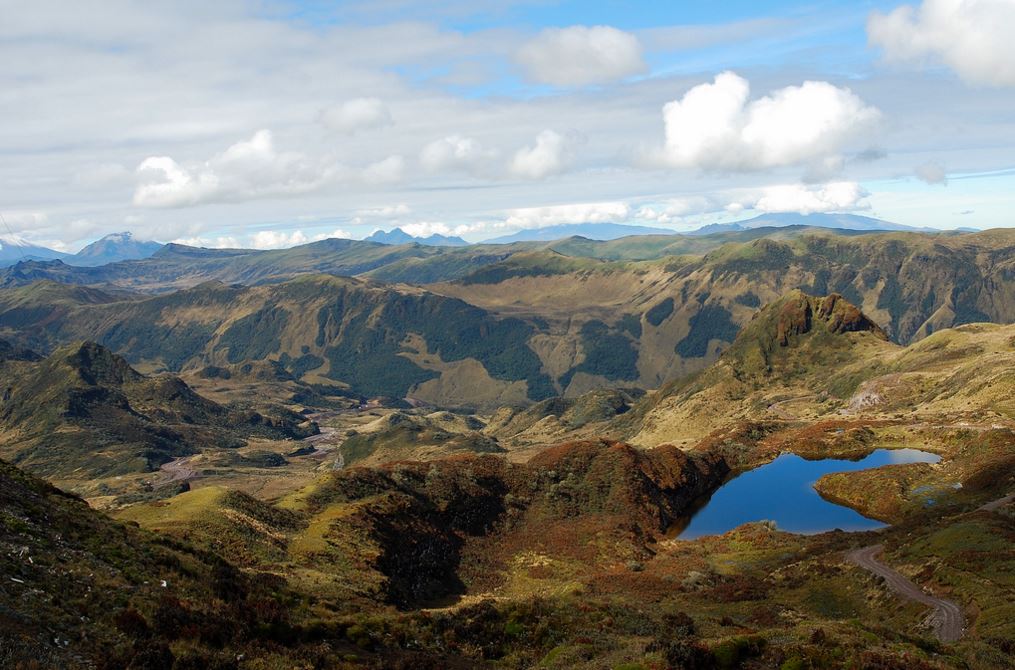In the four years that my wife and I have lived in Cuenca, at an elevation of around 8,500 ft., we’ve known several people that have left because of altitude-related medical issues.
People visiting Cuenca may not immediately notice the effects of increased elevation, except for some mild symptoms of altitude sickness (headaches and breathlessness are common). These symptoms usually diminish after two or three days. Many people assume that there is less oxygen at higher altitude, but the amount of oxygen is actually the same as it is at sea level (about 21 percent of the atmosphere). What is different, however, is the partial pressure of the atmosphere, which helps push oxygen molecules across the membranes of our lungs.
The body’s first response in trying to acclimatize to altitude is to increase both heart and respiratory rate. After a week or so, the body will also start manufacturing more red blood cells, which contain oxygen-carrying hemoglobin. Can’t catch your breath? At an altitude with less atmospheric pressure, the critical exchange of oxygen and carbon dioxide across the membranes in the lungs is slowed considerably, and increased respiration is triggered by the build-up of carbon dioxide molecules in the blood.
If you are considering moving to a high-elevation area, it is extremely important that you understand how this might affect your health. People with a history of the following conditions are advised to discuss their plans with their health care providers:
- Heart disease (CAD, heart attack, arrhythmia)
- High blood pressure
- Diabetes, as altitude affects circulation overall and especially in the kidneys
- Respiratory diseases (asthma, emphysema, COPD)
Something to be very cognizant of is that living at altitude can exacerbate existing health challenges and even manifest new health issues. Know your personal risk factors before you commit to living at altitude.
It’s also a good idea to familiarize yourself with the symptoms of altitude sickness and a few strategies to reduce its impact. Some of the more common symptoms include:
Fatigue Malaise Ringing of the ears
Dizziness Nausea Blistering
Breathlessness Vomiting Purpling of hands/feet
Headaches Body Pain Dilated Veins (legs)
Insomnia Loss of appetite Distorted vision
*If any of these persist for more than two to three days, you are advised to seek medical care.
To avoid the above symptoms (or at least reduce them):
- Avoid drinking alcohol and caffeine, as both increase dehydration
- Keep your level of exertion at a conversational rate (don’t go faster than you can talk), and rest when you need to
- Drink more water than usual, two to three times your normal intake
- Decrease your salt consumption, which affects blood pressure and water regulation
- Eat a well-balanced diet (your body is working harder at elevation so you will use more calories)
- UV protection for skin and eyes (hat, sunglasses, etc.)
- Wear appropriate clothing to adjust to warm/hot days and potentially freezing night temperatures
Additional factors that can affect your physiological response to higher elevations when traveling or moving up to altitude include:
- How quickly you ascend to your destination. If possible, spend a day or two at a lower-to-medium elevation, especially if you will be heading over 10,000 ft.
- The elevation of your destination (10,000 ft or higher may require more time to acclimatize or medication).
- Your level of physical activity (when in doubt, slow down or stop).
- What you eat and drink
- Your current health/medical issues: please consult your health care provider before you book your trip
Active travelers (hikers, fishermen, etc.) should be familiar with the symptoms of edema-related problems, such as:
- Pulmonary Edema: Pneumonia-like symptoms (water in lungs), wet cough, pink to red sputum (blood in lungs)
- Pericardial Edema: Increased water in the sac (pericardium) around the heart, affecting heart function
- Cerebral Edema: Water build-up around the brain
The prescription of each of these is the same: get the person to a much lower elevation immediately. If not, death can result within a few days in some cases.
If considering a trip or move to a high altitude destination, do your due diligence and make an honest assessment of your current health issues and anything that might be triggered by living at high altitude. The last thing you want is to get to your destination and find out you just can’t live there.





















10 Responses
Excellent piece
Ken D. – Could you clarify your statement, “Many people assume that there is less oxygen at higher altitude, but the amount of oxygen is actually the same as it is at sea level”
It seems to me that available oxygen must be less as altitude increases. Otherwise why do some climbers of Everest require Oxygen Systems if amount of Oxygen is the same as it is at sea level?
The pressure on our bodies is about the same as ten metres of sea water pressing down on us all the time. At sea level, because air is compressible, the weight of all that air above us compresses the air around us, making it denser. As you go up a mountain, the air becomes less compressed and is therefore thinner.
The important effect of this decrease in pressure is this: in a given volume of air, there are fewer molecules present. This is really just another way of saying that the pressure is lower. The percentage of those molecules that are oxygen is exactly the same: 21%. The problem is that there are fewer molecules of everything present, including oxygen.
So although the percentage of oxygen in the atmosphere is the same, the thinner air means there is less oxygen to breathe.
Just Google it gents, oxygen level DECREASES with altitude and in Cuenca is roughly 30% LESS than at sea level, period!
False. Oxygen will always make up 21% of the air in the atmosphere. Its the pressure that changes.
The important effect of this decrease in pressure is this: in a given volume of air, there are fewer molecules present. This is really just another way of saying that the pressure is lower. The percentage of those molecules that are oxygen is exactly the same: 21%. The problem is that there are fewer molecules of everything present, including oxygen.
There are also altitude meds you can take (not mentioned here) to ease in the adjustment to being in higher altitudes. We take the meds every time we come down for the first couple of days – no problems so far.
I’ve spent time in Tibet on a bicycle tour from Lhasa to Kathmandu. These comments are based on experiece in the range from 4000 to 5000 m. I took the tour twice because I had problems with the elevation the first time and had to leave. The second time, another member of the party had to leave because of symptoms of HACE (cerebral edema). The elevation of Cuenco is about where AMS can start to appear.
There is a medicine, Acetazolamide (aka diamox) that helps with acclimation. Besides AMS, it is used as a treatment for glaucoma.
We flew into Lhasa, about 4000 m, from KTM, about 1500 m., which caused a raging headache which lasted through the next day. I still got a headache the next year, but it was much milder.
Although I had some diamox with me, I had to leave the tour the first year because advice at the time suggested that you shouldn’t take it because it might mask deadly symptoms. This was not true. It can be used as a prophylactic / treatment. If you feel better, you are better.
Sleep can be a problem at altitude. The trigger to breathe is a buildup of carbon dioxide in the blood. The air can be too thin to create sufficient acidity from CO2, and I would keep waking gasping for breath.
Although I still had some problems, particularly with appetite, the diamox allowed me to complete the trip one year later.
http://www.high-altitude-medicine.com/ is based in Nepal and is a comprehensive reference for the trekkers and climbers that visit the country.
This post lists the symptoms of acute altitude sickness, but it is important to realize that deacclimatization may occur at any point in time, even after a low lander appears to have successfully adapted. This blog post discusses the mechanisms in a little more detail and includes a link to 80 scientific articles on the topic: https://goodbyeusahelloecuador.wordpress.com/2016/03/30/losing-adaptation-to-moderate-altitude/
From http://www.berkeleywellness.com/self-care/preventive-care/article/avoiding-altitude-sickness
Alternatively, consider ibuprofen. In a 2012 study in the Annals of Emergency Medicine, people who took this over-the-counter pain reliever were less likely to develop AMS when they climbed from 4,100 feet to 12,570 feet in the White Mountains of California, compared to those taking a placebo. The dose was 600 milligrams, three times a day, starting six hours before ascending. Another study, in Wilderness & Environmental Medicine in 2010, found ibuprofen as effective as acetazolamide in trekkers in Nepal. Separate from its analgesic effects, ibuprofen inhibits prostaglandins and other inflammatory substances that can contribute to tissue swelling in the brain. Some earlier research has shown possible benefit from aspirin against high altitude headache as well, but mixed results for naproxen.
These all sound like serious concerns at higher altitudes. Family is considering moving to 8000 feet above sea level and I have a question. A member of our family struggles with issues related to a vestibular balance and a blocked eustachian tube. Is anyone familiar with the effects of altitude on the sinus and ear cavities?
Thanks in advance for your thoughts on this.